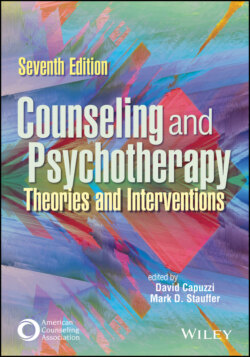Читать книгу Counseling and Psychotherapy - Группа авторов - Страница 28
HELPING RELATIONSHIPS: STAGES
ОглавлениеThe helping relationship is a constant throughout the counseling or psychothera-peutic process. The definitive characteristics we have already discussed indicate that the relationship must be present from the initial meeting between the client and the counselor or therapist and continue through closure. Viewing the helping relationship as a constant throughout the helping process leads to visualizing this process from a developmental perspective. This development can best be viewed in terms of a narrow path whose limits are established by the client’s fear, anxiety, and resistance. Such client reactions should not be seen as lack of commitment to change; rather, they need to be understood in terms of the unknown nature of this developing alliance and the fact that this may be the first time the client has experienced this type of interaction. These reactions are often shared by the counselor or therapist based on their level of experience. The path broadens through the development of trust, safety, and understanding as the relationship develops. The once narrow path becomes a boulevard along which two persons move courageously toward their final destination—change. The movement along this broadening path is described by various authors in terms of stages or phases. Osipow et al. (1980), in discussing the stages of the helping relationship, stated,
Persons who experience the process of personal counseling seem to progress through several stages. First, there is an increased awareness of self and others. Second, there is an expanded exploration of self and environment (positive and negative behavioral tendencies). Third, there is increased commitment to self-enhancing behavior and its implementation. Fourth, there is an internalization of new and more productive thoughts and actions. Fifth, there is a stabilization of new behavior. (p. 73)
Egan (2013) stated that the helping relationship can be broken down into a minimum of three phases: building the relationship, challenging the client to find ways to change, and facilitating positive client action. The goal in the first phase is to build a foundation of mutual trust and client understanding. In the second phase, the counselor challenges the client to try on new ways of thinking, feeling, and behaving. In the third phase, the counselor aids the client in facilitating actions that lead to change and growth in the client’s life outside the counseling relationship.
Stages are connected to pantheoretical helping skills that counselors-in-training practice. These skills should be tied to theory, case conceptualization, and multicultural and social justice competencies and cultural humility. For example, in Hill et al.’s (2014) pantheoretical three-stage model, counseling students learn skills such as reflection of feeling to build relationship and share their narratives in stages. In Stage 1 (exploration), they learn skills to establish the therapeutic working relationship; in Stage 2 (insight), they learn skills such as immediacy to facilitate client discovery of new understandings and interpretations; and in Stage 3 (action), they learn skills to help clients in the active process of making meaningful change.
Corey and Corey (2021), Gladding (2018), and Egan (2013) provided other models of the developmental nature of the stages of helping relationships. Although the terms used to describe these stages may differ, there seems to be a consistency across these models: The stages move from initiation of the relationship through a clinically based working stage to a termination stage. The following developmental stages show our conceptualization of this relationship-building process and are based on the consistency found in our research and our clinical experience:
Stage 1: Relationship development. This stage includes the initial meeting of the client and counselor or therapist, rapport building, information gathering, goal determination, and informing the client about the conditions under which counseling will take place (e.g., confidentiality, taping, counselor/ therapist and client roles).
Stage 2: Extended exploration. This stage builds on the foundation established in the first stage. Through selected techniques, theoretical approaches, and strategies, the counselor or therapist explores in depth the emotional and cognitive dynamics of the client, problem parameters, previously tried solutions, and decision-making capabilities of the client. There is also a reevaluation of the goals determined in Stage 1.
Stage 3: Problem resolution. This stage, which depends on information gained during the previous two stages, is characterized by increased activity for all parties involved. The counselor’s or therapist’s activities include facilitating, demonstrating, instructing, and providing a safe environment for the development of change. The client’s activities focus on reevaluation, emotional and cognitive dynamics, trying out new behaviors (both inside and outside of the sessions), and discarding those behaviors that do not meet goals.
Stage 4: Termination and follow-up. This stage is the closing stage of the helping relationship and is mutually determined by all persons involved. Methods and procedures for follow-up are determined prior to the last meeting (see Sidebar 1.2).
